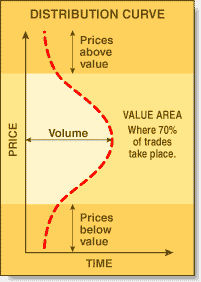TRADING TECHNIQUES
Market Profile Basics
by Jayanthi Gopalakrishnan
Every off-floor trader would like to get a feel for how things really are on the exchange floor. Mastering Market Profile may help you get it.
Worried that you'll never be able to compete with the floor traders? After all, they're right there in the middle of the action. They're privy to information that off-floor traders see late or maybe never. Once you start using Market Profile, however, you may find yourself with more information than the floor trader. No longer will floor traders, decked out in their colored jackets, frantically gesturing and scrambling to make themselves heard and seen by other traders, seem chaotic, intimidating, or bizarre. Instead, with the use of Market Profile, you will see the order in the markets.

FIGURE 1: MARKET PROFILE STRUCTURE. The structure of Market Profile follows that of a normal distribution curve of price occurrences.
J. Peter Steidlmayer developed Market Profile in the 1980s in conjunction with the Chicago Board of Trade. Traders who use it say that they get an in-depth understanding of the market, contributing to improved trading. Many factors can be monitored from Market Profile.
Market Profile is not an indicator in the typical sense. It does not provide buy/sell recommendations but acts more like a decision-support tool. It organizes the data so that you can understand who is in control of the market, what is perceived as fair value, and the direction of the price move. It is possible to extract enough information from Market Profile for you to position your trades more advantageously.
Market Profile is useful for the pit trader as well as the off-floor trader. The indicator can help the off-floor trader get a better sense of the market; prior to the introduction of Market Profile, only floor traders had access to this information. Although all references here refer to using futures contracts, Market Profile can be used just as effectively for other tradables. Software vendors such as CQG and WindoTrader provide Market Profile displays for equities.
IN THEORY
The concept of Market Profile stems from the idea that markets have a form of organization determined by time, price, and volume. Each day, the market will develop a range for the day and a value area, which represents an equilibrium point where there are an equal number of buyers and sellers. In this area, prices never stay stagnant. They are constantly diverging, and Market Profile records this activity for traders to interpret.
Market Profile is based on the normal distribution curve, wherein approximately 70% of the values fall within one standard deviation of the average. If you rotate the normal distribution curve so that price is along the vertical axis and time on the horizontal axis (as shown in Figure 1), you have the structure of Market Profile.
A normal distribution curve assumes that the number of occurrences follow a bell-shaped curve. Anyone who has traded in the markets, however, knows that prices never follow a definite pattern; in fact, you rarely see a normal distribution. What you do see are skewed distribution of prices, which makes it possible to see the price at which most of the trades actually took place. This provides significant clues about the direction of prices and is the groundwork for understanding Market Profile. In theory, this helps the trader identify where prices are in relation to values.
Monitoring price distribution over time gives insight into what levels are considered fair and unfair. You may take advantage of this information and identify good trading opportunities.
Jayanthi Gopalakrishnan is a Staff Writer for STOCKS & COMMODITIES magazine.
Excerpted from an article originally published in the December 1999 issue of Technical Analysis of STOCKS & COMMODITIES magazine. All rights reserved. © Copyright 1999, Technical Analysis, Inc.
Return to December 1999 Contents